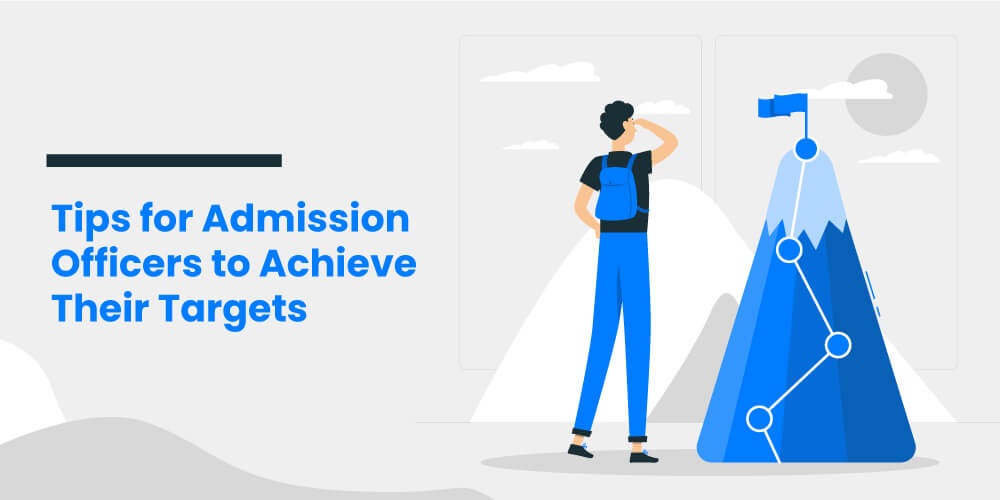A lot has changed in the last couple of years for college admissions. While the number of colleges has increased, students now have more options to pursue higher education. On top of that, online learning is also becoming mainstream. According to the Center for American Progress, annual undergraduate enrollment across all higher education institutions fell by 1.25 million students from 2014-15 to 2018-19 academic year, a decline of 5 percentage points. Also, during this period, undergraduate enrollment in public colleges dropped by 425,000 students—a nearly 2.5 percent decline.
Amidst this, how can admission officers analyze the applications of prospective students, communicate with them effectively, and attract the best talents to enroll in their schools/colleges?
We spoke to admission heads of leading higher educational institutions in the United States and understood some gaps in their enrollment process. And we arrived at a solution – using technology-based solutions such as Admissions CRM, admission officers can easily achieve their recruitment targets. You can listen to enrollment experts – Tom King and Lexington Maximus from The Art of Admissions or read the takeaways below.
Tips for Admission Officers to Achieve Their Enrollment Targets
While colleges are spending time recruiting reps, they don’t always have the right resources to optimize their performance. This seemingly simple shortfall leads to unfilled classes.
The following tips can help admission offers in better recruitment.
1. Chase the right KPIs
Getting hold of a student, setting an appointment, and ensuring they show up is, no doubt, difficult. It is also the most important part of your enrollment cycle.
Once they show up, it’s relatively simple to get them excited with virtual or in-person tours (especially if they are even slightly interested in your program). If you can master the “lead capture to showing up” process, you can expect a massive increase in your enrollments.
However, when we asked admission officers, what KPI(s) are most important for your admissions team, 65% of them responded – number of starts.
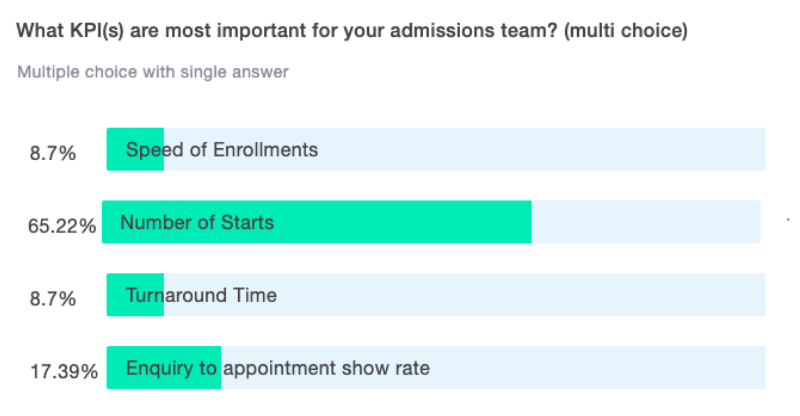
We get the impression that admission counselors are more focused on the results, whereas they should focus on the KPIs that will bring those results.
Career schools and colleges that successfully meet their admission targets focus on the following KPIs.
- Lead contact rate: It is the percentage of inquiries that admission officers contact via phone calls/emails
- Appointment set rate: The percentage of student inquiries that translate to appointments
- Appointment show rate: The percentage of appointments that show up for counseling, virtual campus tours, etc.
- Application rate: It is the percentage of students who showed up apply for a course
- Enrollment rate: It is the percentage of applicants who enroll.
- Start rate: The percentage of enrolled students who start.
Once you start tracking these KPIs, you will know exactly where the problem is. For example, if your appointment show rate is low, you’ll devise measures to fix that. You can send reminder SMS/WhatsApp text to the students about the appointment schedule and reduce the instances of no show.
This way, by monitoring individual KPIs, you can fix the bottlenecks and close more admissions.
2. Create an enrollment process for your internal teams and follow it diligently
Many times, institutions have a chaotic, unstandardized follow-up process. They often don’t know where the inquiry is coming from and who is following up with them. It is also the reason for a low inquiry-to-appointment show rate.
When we asked higher-ed institutions about their inquiry-to-appointment show rates, 58% of schools have an inquiry-to-appointment show rate below 30%.
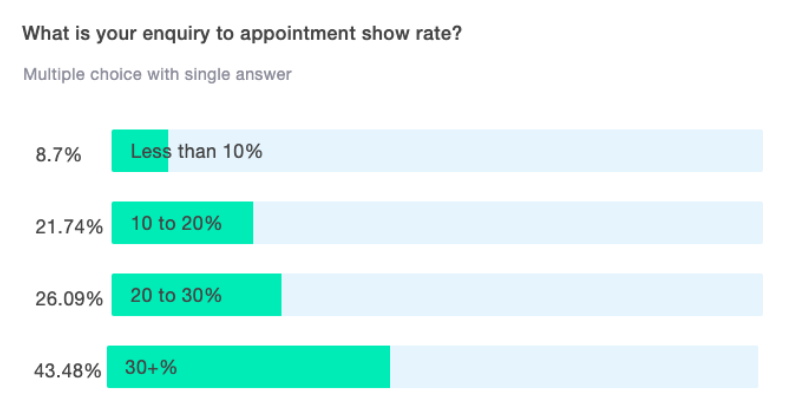
Most admission reps want to maximize their “Appointment Set” rates. But, not all of them are good at appointment setting. It’s not that they’re not putting efforts. But the gap is because they are not trained for such tasks. Also, because they are doing everything else – engaging with prospects, doing paperwork, getting the enrolled students started, and 100 other tasks – they don’t have enough hours a day to set appointments.
Solution: To let your staff focus on a dedicated task, split your admissions team to handle the following tasks.
- Setting appointments: Have dedicated staff to set appointments for counselors/reps. Result = Higher appointment rates = Higher show rates.
- Admission Reps: These are the people that love face-to-face or virtual interactions, showing off what your school is all about, making a great connection, and can get those enrollments.
- Student Coordinators: These are the people that handle all of the paperwork, ensure that everyone can get the financial aid they need, facilitate orientation or other meetings. These are the people that make those starts happen. You don’t want your admission reps or your appointment setters chasing these jobs.
So, when your staff/team members are able to do their tasks proactively, you’ll observe better results.
3. Have a contact strategy in place
In our survey, we found out that 40% of schools do not have a set cadence. Only 10% of schools have a set script (a specific sequence of emails and call scripts).
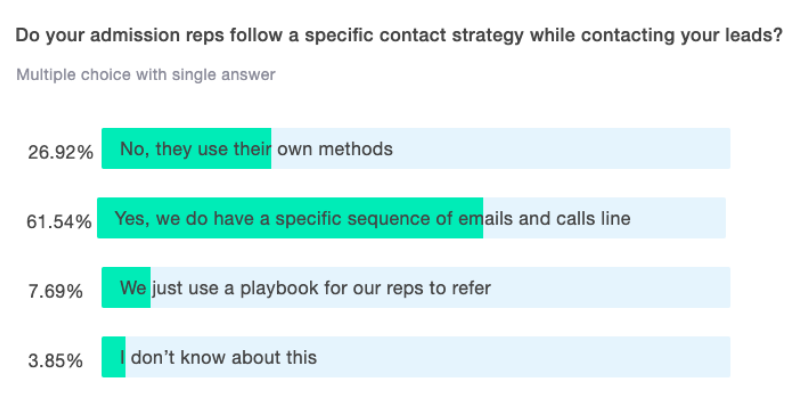
If you let your reps use their unique methods every time, you will never know what works the best. If your team doesn’t know what to communicate, there’ll be inconsistency and ambiguity in your messaging.
So, brainstorm and create a plan (with scripts, replies, resources) before the enrollment season. Share all the materials with everyone involved in the admission process.
To sum up:
- Plan a contact strategy: Your team must know when to call/text and when to email. Do not over or underdo these.
- Script everything: Define every conversation and everything else that needs to follow a consistent pattern. Aim at exploratory talks. For instance, what interests you in becoming a cosmetologist? What inspires you to become a cosmetologist?
- Prepare a follow-up structure: Define every possible follow-up path. How to follow-up with no shows, with someone who shows up and doesn’t apply, and for every possible drop-off point.
4. Influence students to enroll in your course
We found that 42% of schools have an appointment-to-enrollment rate below 30%.
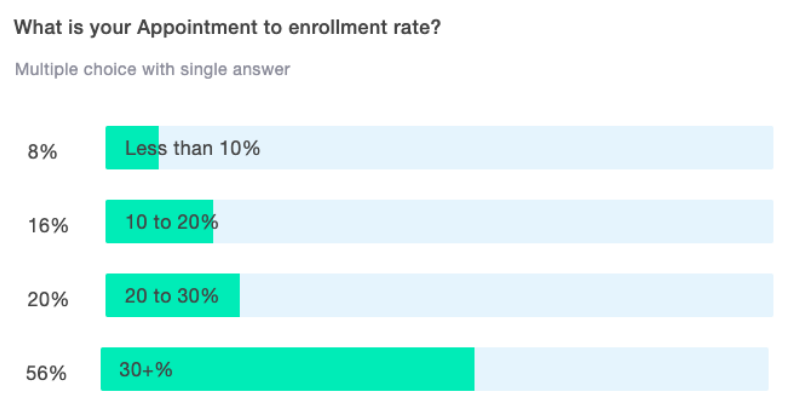
In the thick of the new normal, with fewer campus tours and events, schools are failing at encouraging their desired students to enroll. Relying just on word of mouth doesn’t help reps build prospect relations. Campus tours exist to attract students with the look and feel of the college. Without this, schools are witnessing many drop-offs from their admissions funnel.
However, you can still focus on virtual presentations and campus tours and recreate a similar experience. We have seen virtual presentations increase the lead-to-show rate by 29% and the lead-to-application rate by 19%. Virtual presentations are much easier as compared to in-person interactions. They can be fun, are much faster and compliant. Here are the best ways to do virtual presentations:
- Direct Your Set: Use green screens, good microphones, good light source, good video camera, etc., and it could all be set up for under $400.
- Direct Your Audience: Make the presentation engaging and charismatic, rather than just reading the lines mechanically. It will inspire way more action.
- Direct Yourself: Train your admission reps to be great presenters. Don’t just leave them with a camera and a Zoom room.
With a helpful presentation, you can influence students to apply and enroll. Also, check out this article that talks about student engagement strategies for enrollment.
5. Take ownership
In general, because of the lack of a streamlined process, admission officers don’t have complete ownership over leads. That is why the instances of missed follow-ups and lesser enrollments.
A simple way to make your team accountable for their tasks is to track their performance regularly. However, not all institutions do that. We found out that nearly 40% of higher-ed institutions generate reports manually (through excel sheets).
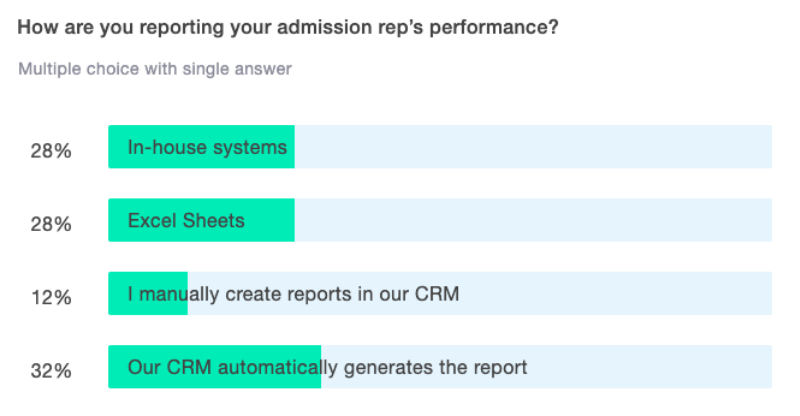
But if you see, tools like Educational CRM provide automated reports that can save hours spent navigating excel sheets. It is also the success mantra of institutions like Asher College, Stratford University, and more.
So, get an admissions CRM that lets you customize and generate daily activity reports with just a few clicks. You can create custom dashboards and see just the information that matters to you and remove the rest of the noise.
To make your task easy, here’s a recommendation.
“With LeadSquared, our contact rate went up by 13%, and scheduled campus appointments improved by 5%,” says Kim Gasper, Corporate Director of Marketing, Asher College.
So, give a try to LeadSquared Higher Education CRM.
FAQs from Admission Officers
To become a smart admission officer, work on interpersonal skills, gather in-depth program knowledge, automate repetitive tasks such as reporting and emails, and use digital tools to work more efficiently. Software that is very helpful for admission officers throughout the enrollment process is Admissions CRM.
The main role of the admission officer is to analyze the applications of prospective students based on the institution’s admission policies. They interview students to understand their objectives and background. Admission officers also provide clarifications to student’s queries and guide them on their career goals.
An admissions representative is a staff member at a school or college who works with prospective students throughout the application process.







